UX MasterTrack Certificate, University of Minnesota: UX Research and Design Project
2022 - Timeline: 3 months
Social Justice Virtual Book Club
I have been a member of a small virtual book club focused on anti-racism for a few years. Our members met during the breakout sessions for a seminar on anti-racism and we decided to keep meeting monthly to learn more about the topic. Some of us use ereaders and some read physical books.
Small face-to-face virtual book clubs facilitate close friendships and in depth study of a topic, but they lack some of the benefits of large online book clubs with apps. I wanted explore some of the benefits of larger groups and see if there are ways that members who read digital books can share notes with members who read physical books.
How might we enhance a social justice virtual book club with the following?
- Central place to communicate between meetings
- Better ways to share notes between members
- Vetted list of opportunities to volunteer, donate or support minority-owned stores
Competitive and Domain Analysis
I looked at a few competitors in the online book club space to learn more about what works and what doesn't work in this domain.
Reese's Book Club App and Bookclub.org are competitors in the online book club space.
Areas where current virtual book clubs succeed:
- Zoom events like presentations from authors and book discussions
- Online forum discussions for books in progress
- Supporting diverse writers and promoting of underrepresented voices
- Videos with author readings, Q&A, and celebrity chats with authors
- Personalized events, books read, and books in progress section
- Many genres of clubs to choose
- Discussion guides for popular books
- Find a book section
- Community forum to promote new clubs or ask questions
- Calendar view with all book club events
Areas of improvement for current virtual book clubs:
- Large group so it is harder to form connections with people
- Cannot make online donation without purchase
- Some clubs aren’t very active
- Club discussions are in discord for the club I joined
- Search for clubs by location did not work well
- Many features only available on app, not on website (not available on older phones)
Persona
Based on research and interviews with members of my social justice book club, the target persona was developed as a retired woman who is an active volunteer in her community.
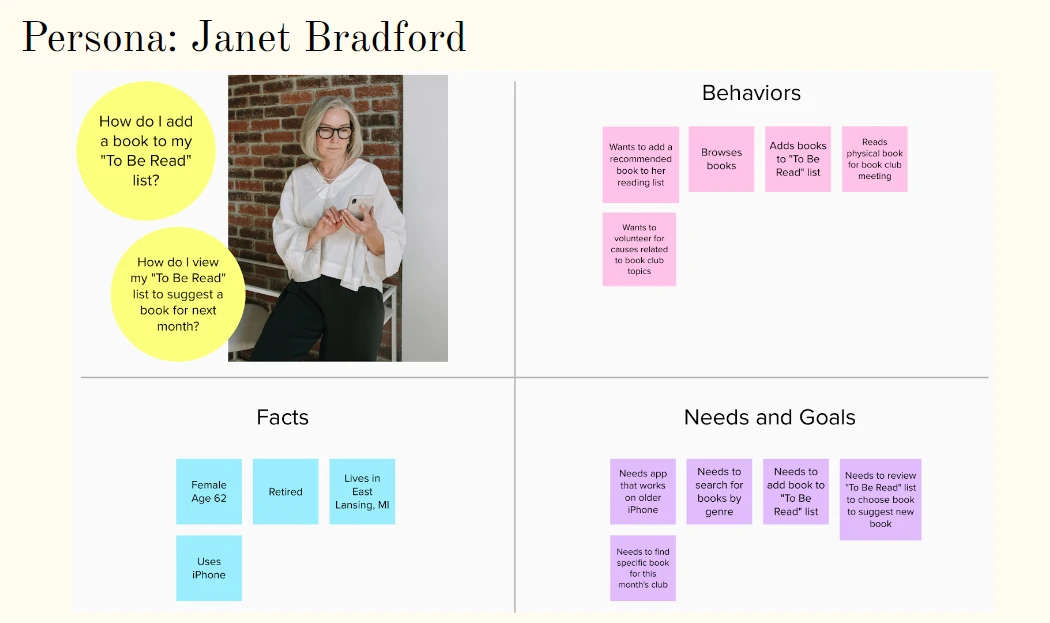
Janet Bradford is the persona for a social justice virtual book club. She is retired, enjoys reading, and is active in her community as a volunteer.
Brainstorming
Some brainstorming techniques I used were Mind Mapping, Affinity Diagrams, and Card Sorting
The Mind Map highlighted similarities and differences between large and small virtual book clubs.
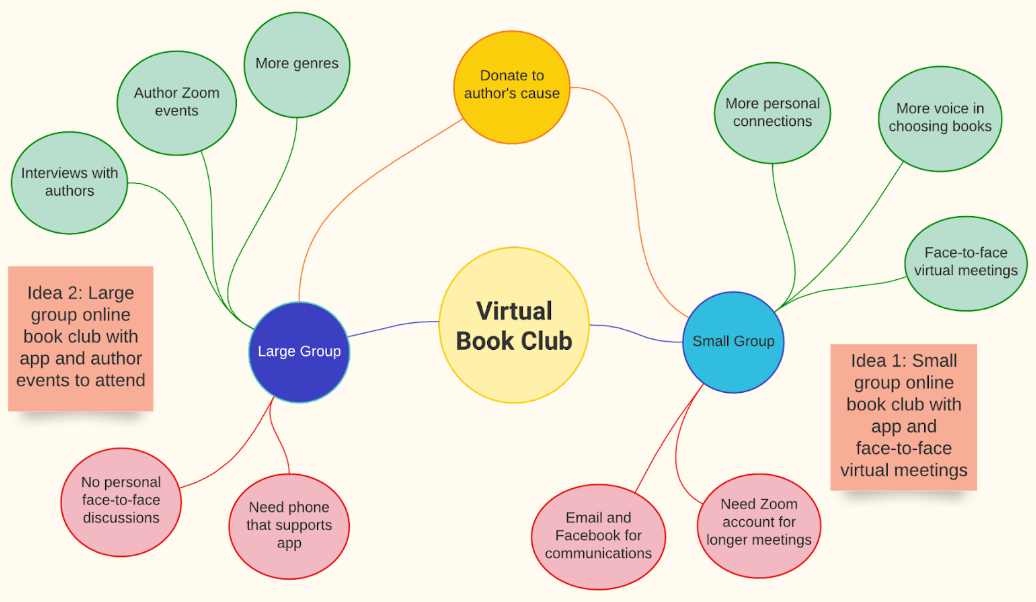
Mind Map
An Affinity Diagram helped to narrow my focus for the journeys that might be accomplished with the app. I decided to concentrate on communication between members, making a difference, and sharing information between readers with digital and physical copies of their books.

Affinity Diagram before sorting
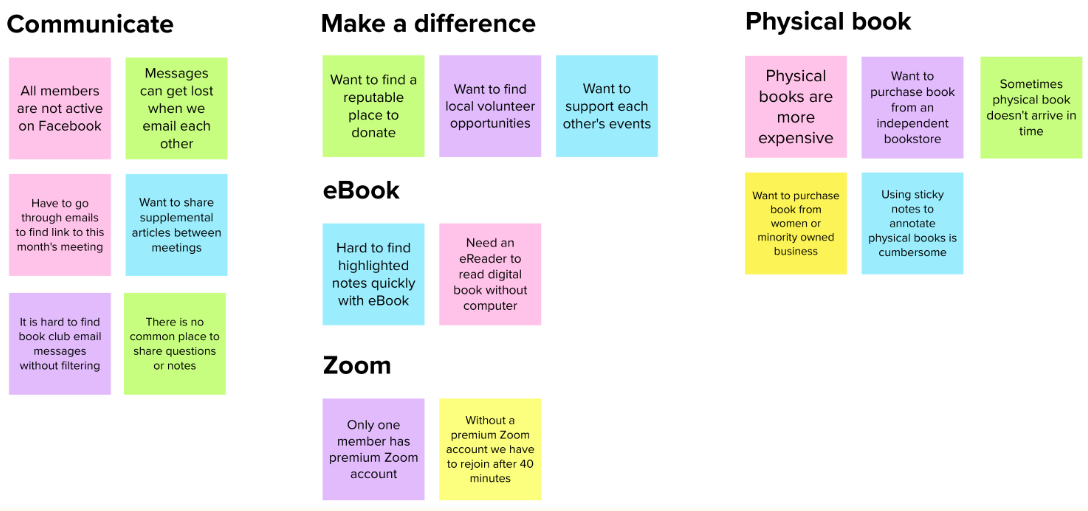
Affinity Diagram after sorting
I did both an open and a closed card sort to dive deeper into how to group the information in the app into categories. The open sort was difficult for users, but the closed sort confirmed my general categories made sense to users: Book Club, Give Back, Books, Manage My Booksm and My Account
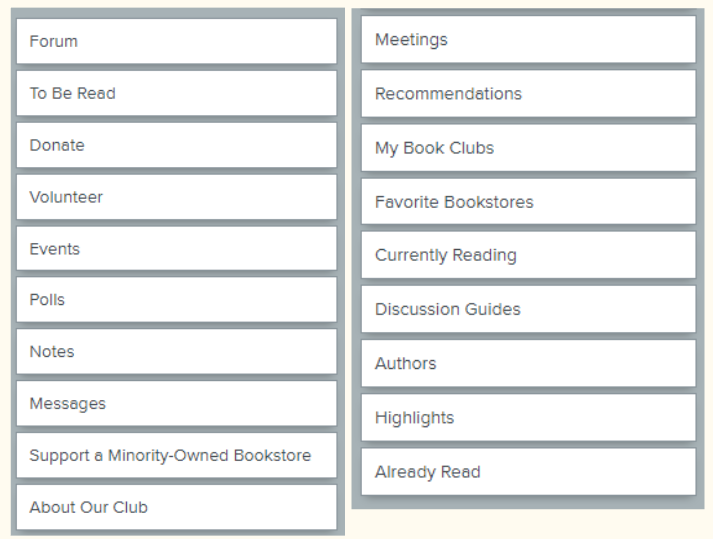
Card Sorting Topics
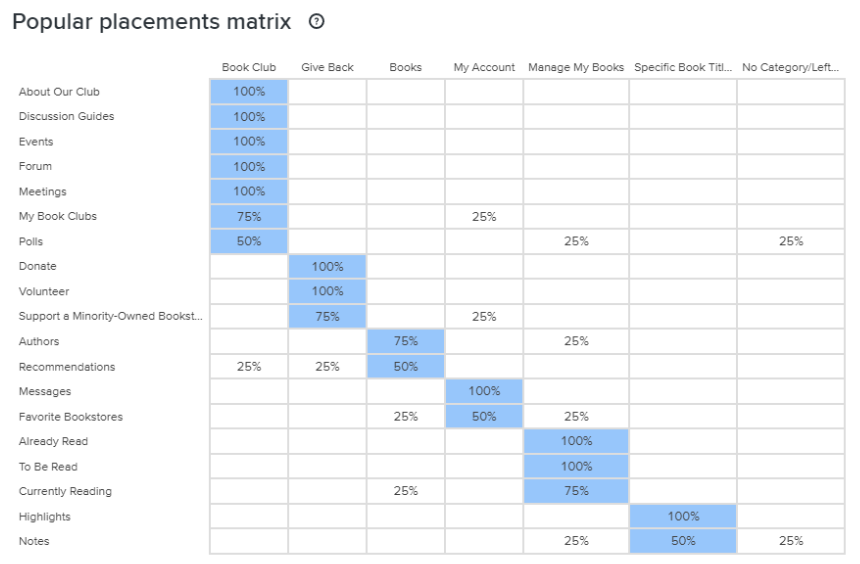
Closed Card Sorting Results Matrix
User Testing
I used a variety of testing, but found the most useful results from A/B testing, user testing with a clickable prototype in Axure, and an expert evaluation.
- A/B Testing showed users preferred drop down lists to buttons for adding a book to a list and toggle buttons instead of checkboxes for filtering book lists
- User testing with the clickable prototype highlighted workflows that could be improved such as adding a book to the app without purchasing it, searching for a club to join, joining and viewing multiple clubs, and adding notes and highlights from a physical book into the app.
- The expert evaluation gave me ideas on consolidated my layout and improving the information architecture by rearranging elements on the screen and moving less used categories into the menu. The evaluator also cautioned against reinventing a model that already works well for users like the Kindle eReader.
Users were asked to complete the following journeys with the clickable prototype:
- Search for a book
- Open a book to read
- Organize books into lists
- Add a book to the app
- Purchase a physical copy of a book
- Change the bookstore where you make your purchase
- Donate or volunteer
- Add notes to a book by typing, speaking, or taking a picture of a physical book
Next Steps
Next steps would include...
- Improving the section on adding notes to behave more like the Kindle
- Making the search options for joining a club clearer by adding prepopulated results and filtering to enhance the search
- Exploring ways to show notes from multiple users of the app who are using both physical and digital copies of a book